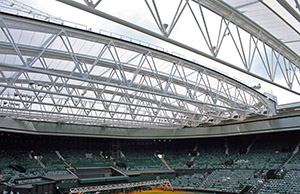Jul 8 2009
The reputation of UK engineering is soaring after the successful deployment of the new roof at Wimbledon Centre Court. The bogeys supporting and driving each of the 10 space frame trusses were manufactured by industrial crane specialist Street Crane in Chapel-en-le-Frith, Derbyshire. The entire moving structure was designed and engineered by the SCX Group of Sheffield.
 The automatic roof on Wimbledon's Centre Court is designed to close in 10 minutes or less, against wind speeds of up to 43 miles per hour
The automatic roof on Wimbledon's Centre Court is designed to close in 10 minutes or less, against wind speeds of up to 43 miles per hour
SCX and Street Crane have a common heritage spanning more than half a century. Formerly known as Street CraneXpress, SCX provide maintenance services for Street Crane equipment installed in UK factories. In recent years SCX has also made a speciality of the design and delivery of architectural movement for which they frequently call on the manufacturing capability of sister company Street Crane.
"This was a highly unusual brief," explained Street Crane designer Andy Robinson. "There are 20 four wheel bogeys supporting and driving the roof trusses. These are manufactured to exceptional tolerances, including precisely located brackets for the power and control signal pick up. High specification welding had to be one hundred percent tested and certified. Superior finishes to the bogeys ensured they were in keeping with such a prestige location."
SCX electro mechanical design included the development of an extremely sophisticated system to regulate the 100 drives which control the movement of the roof components to a tolerance less than plus or minus one millimetre. Prototypes were extensively tested in a three truss mock-up to prove the reliability and precision of the movement before final manufacture.
The roof is designed to close in 10 minutes or less, against wind speeds of up to 43 miles per hour. Covering 5,200 square metres, the overall construction, including fixed and moving elements, weighs more than 3000 tonnes. Each truss weighs 100 tonnes and is greater in span than the width of a football pitch. Conceptual and structural design for the new roof was undertaken by Bianchi Morley, Populus and Capita Symonds.
Street Crane managing director Andrew Pimblett concluded, "The engineering of factory cranes has become vastly more sophisticated over the last ten years. It is interesting to see how this technology can be so successfully adapted for use in a totally different environment".